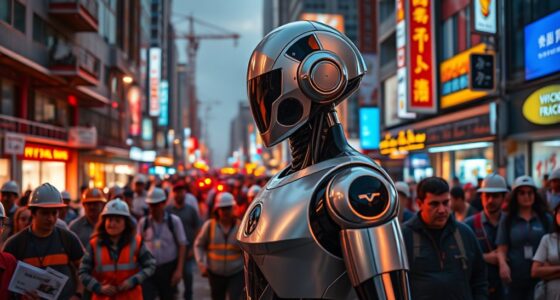Many jobs will change with automation, but not every role will be fully replaced by machines. Routine tasks are more vulnerable, while jobs requiring emotional intelligence, creativity, and complex decision-making are less likely to be automated. The future involves humans working alongside AI, blending skills to improve efficiency. If you want to understand how to stay relevant and adapt, continue exploring how the workplace is evolving in this shift.
Key Takeaways
- Most jobs involve complex, creative, or emotional tasks that are less susceptible to automation.
- Automation primarily targets routine and repetitive tasks, not entire roles.
- Human skills like emotional intelligence and decision-making remain difficult for AI to replicate fully.
- Future work will likely involve humans collaborating with AI, not complete job replacement.
- Some sectors and roles will remain largely human-driven due to the need for empathy, judgment, and adaptability.
The Current State of Automation and Its Capabilities

Automation technology has advanced rapidly, transforming workplaces across industries. You’ll see AI increasingly integrated into daily operations, with 62% of employees aged 35-44 reporting high AI expertise. Businesses use automation software to boost productivity by automating routine tasks, saving time and reducing costs. Machine learning algorithms continually improve automation efficiency and accuracy, making processes smarter and more reliable. Robotics are now common in manufacturing and logistics, streamlining operations and increasing output. Data analytics help optimize automation, guiding better decision-making and resource allocation. These advancements enable faster, more precise work, leading to significant cost savings and improved customer experiences. While automation’s capabilities grow, they mainly focus on specific tasks, not replacing every job but enhancing operational efficiency across sectors. Automation’s impact on employment remains a topic of ongoing debate, as many roles are augmented rather than eliminated. Additionally, understanding the types of automation involved can help businesses better implement these technologies effectively. As these technologies evolve, the importance of adaptability in the workforce becomes increasingly vital to navigate changing job requirements. Moreover, the development of specialized tools like eye patches demonstrates how targeted innovations can improve individual well-being and productivity. Furthermore, incorporating industry-specific automation solutions allows companies to tailor systems for optimized performance in unique operational environments. Recognizing the different levels of automation can assist organizations in planning gradual integrations aligned with their capabilities and goals.
Sectors Most Vulnerable to Automation

Certain sectors face a higher risk of job disruption due to advances in AI and robotics. Data entry, customer support, finance, manufacturing, and transportation are especially vulnerable. Routine, repetitive tasks are prime targets for automation, reducing the need for human workers. For example, data clerks and processors can be replaced by machine learning systems that process data faster and more accurately. Customer service roles in retail and call centers are increasingly handled by AI chatbots. Financial jobs involving bookkeeping and invoicing are at risk as AI handles routine tasks. Manufacturing jobs, especially on assembly lines, face significant automation, with robots taking over repetitive work. Transportation sectors, including logistics, are also highly susceptible, as AI-driven vehicles and warehouse systems streamline operations. Understanding automatable tasks helps identify which roles are most vulnerable to this technological shift.
Jobs That Are Less Likely to Be Automated

Jobs that involve high emotional intelligence, creativity, and complex decision-making are much less likely to be automated. You’ll find these roles in healthcare, education, arts, and social services, where human interaction and empathy are essential. For example, nurses, therapists, teachers, and counselors rely on emotional understanding that AI struggles to replicate. Creativity-driven careers like choreographers and artists also remain resistant to automation because they require original thinking and nuanced expression. Additionally, jobs demanding quick, complex decisions—such as emergency responders and athletic trainers—are less vulnerable. These roles value adaptability, resilience, and leadership, making them difficult for machines to replace. As the world shifts, your skills in emotional intelligence, creativity, and decision-making will keep you valuable in the job market. Research shows that roles requiring high emotional intelligence are among the least susceptible to automation because of their reliance on nuanced human interactions. Developing emotional intelligence further can help ensure you stay relevant and indispensable in your career. Recognizing the importance of complex decision-making can also give you an edge in future-proofing your profession. Moreover, understanding regional employment trends can help you identify resilient career paths in changing economic climates. Additionally, embracing human-centric skills such as empathy and communication can further safeguard your professional relevance amid automation advancements. Furthermore, an awareness of Borderline Syndrom dynamics can enhance interpersonal skills and empathy, which are valuable in many high-touch careers.
The Role of Artificial Intelligence in Transforming Work

AI is changing how work gets done by automating tasks across many industries, but it’s not replacing every job. As AI takes on more responsibilities, you’ll need to develop new skills, like working alongside AI systems or managing their outputs. This shift means your future role may focus more on integrating AI into daily operations, making adaptability essential. The ability to adapt to new tools and workflows will be crucial for staying relevant in an evolving workplace. AI’s potential to automate cognitive functions such as reasoning, planning, and decision-making underscores the importance of continuous learning and flexibility in the evolving workplace. Additionally, understanding the impact of automation on business intelligence can help you better navigate these changes and leverage AI effectively. Developing a predictive modeling mindset can further support proactive decision-making in your professional environment. Recognizing the importance of organizational skills can also aid in managing new workflows and collaborative tools efficiently. Embracing reskilling and upskilling will be vital for workers to remain competitive in an AI-driven economy.
AI’s Task Automation Capabilities
Artificial intelligence is transforming work by automating repetitive tasks and streamlining operations across industries. Many businesses already use AI to boost efficiency; 28% have adopted it, and another 45% plan to. AI helps automate data analysis and decision-making, with 48% leveraging big data effectively. Up to 97 million people are involved in the AI space, highlighting its broad impact. While only 20% of leaders expect employees to use general AI for more than 30% of daily tasks within a year, over half of businesses report AI has been transformational. AI’s automation capabilities are expanding rapidly, with advancements expected in 2025, further increasing its role in optimizing workflows, reducing manual labor, and fostering innovation. AI market is projected to grow nearly 5x over the next 5 years, further fueling its integration into daily business operations. Additionally, the development of robust AI systems is expected to accelerate, making automation even more accessible and efficient across various sectors. As the industry trends evolve, companies will continue to explore innovative ways to incorporate AI into their core processes. Moreover, advancements in appliance maintenance plans can help organizations ensure the longevity and safety of automated equipment, supporting seamless integration of new technologies.
Future Skill Demands
As technology continues to advance, the demand for new skills is rapidly evolving to keep pace with innovations driven by artificial intelligence. You’ll need to develop expertise in areas like AI-driven data analysis, cybersecurity, and networking, which are among the fastest-growing skills. Technological literacy becomes essential as understanding and working with new tools becomes a core requirement. Employers seek candidates with strong analytical thinking and programming skills to adapt to automated processes. Flexibility is also vital, as industries demand adaptability to shifting tech landscapes. To succeed, focus on:
- AI-driven data analysis and cybersecurity
- Enhancing technological literacy
- Strengthening analytical and programming skills
- Cultivating adaptability
- Improving collaboration and problem-solving abilities
Staying ahead involves continuous upskilling and embracing change to thrive in an AI-transformed workplace.
Skills That Will Remain in Demand Amid Automation

In a rapidly evolving job landscape, certain skills will continue to be in high demand despite increasing automation. Analytical thinking is essential for interpreting complex data and making informed decisions. Creativity remains crucial for developing innovative solutions that machines can’t replicate. Resilience and flexibility help you adapt to rapid changes in work environments. Leadership and social influence are key for managing teams and guiding organizational direction. Curiosity and lifelong learning ensure you stay current with new technologies. Skills like manual dexterity, endurance, and craftsmanship are less likely to be automated because they require a human touch. Emotional intelligence, complex problem-solving, and skills in social influence and communication will also remain valuable, as they depend on nuanced human interactions that machines can’t fully replicate. Approximately 60% of companies currently utilize automation tools in workflows further underscores the importance of developing uniquely human skills that complement automation rather than compete with it.
How Automation Is Shaping the Future Workforce

Automation is changing the skills you’ll need to stay competitive, emphasizing adaptability and digital literacy. New job roles are emerging, focusing on managing and improving automated systems, while routine tasks become less relevant. To keep up, organizations are prioritizing reskilling efforts that prepare workers for these evolving demands.
Shifting Skill Demands
Automation is fundamentally altering the skills employers value most, elevating analytical thinking, creativity, and adaptability to new heights. As routine tasks become automated, you’ll find that skills like complex problem solving and curiosity are more critical than ever. Employers seek resilience, flexibility, and social influence to navigate rapid changes and foster innovation. Creativity continues to grow in importance, helping you stand out in a tech-driven landscape. Lifelong learning becomes essential to stay current, with the half-life of skills shrinking to just two and a half years. To thrive, you’ll need to develop these core abilities:
- Analytical thinking
- Resilience and agility
- Creative problem solving
- Curiosity and continuous learning
- Social influence and leadership
Emerging Job Roles
As technology continues to evolve rapidly, new job roles are emerging that reflect the changing landscape of work. You’ll see a surge in AI and machine learning specialists, with a projected 40% growth by 2027, as companies seek experts to develop and optimize AI systems. Big data specialists are essential for analyzing and interpreting the vast amounts of information AI generates. Fintech engineers are expanding fast, driven by innovations in financial technology, while security management specialists are increasingly indispensable due to rising digital threats. Roles like autonomous vehicle specialists are also growing, fueled by green energy initiatives. These emerging roles highlight how automation creates new opportunities, requiring you to adapt your skills and embrace new specialties to stay relevant in the evolving workforce.
Workforce Reskilling Strategies
With new job roles emerging alongside advancing technologies, organizations are recognizing the importance of reskilling their workforces to stay competitive. They’re adopting strategies that blend technical expertise with human skills like creativity and adaptability. Industry-specific training, especially in IT, media, and telecom, helps address sector needs. Leaders play a vital role by supporting continuous learning cultures, essential for steering through rapid tech changes. Reskilling also involves accommodating a multigenerational workforce, which requires flexible approaches for diverse learning preferences. Prioritizing lifelong learning ensures organizations remain agile. Key aspects include:
- Balancing technical and soft skills
- Industry-focused training programs
- Leadership commitment to learning
- Inclusive strategies for diverse age groups
- Cultivating a culture of ongoing development
These strategies aim to build a resilient, future-ready workforce.
Economic Impacts of Widespread Automation

Widespread automation is transforming economies by shifting job markets and altering industry dynamics. You’ll see job displacement in sectors like retail, transportation, and administrative services, with millions of roles at risk. For example, up to 50% of driving jobs and 40% of clerical roles could disappear, while sectors like healthcare and financial services stand to gain through increased productivity and cost savings. Even as some industries shrink, new roles will emerge, with a net gain of approximately 12 million jobs globally by 2025. Regions investing in AI development, like North America and China, are expected to see significant economic growth. However, workers in traditional roles and developing economies face higher displacement risks, emphasizing the need for strategic adaptation and reskilling.
Strategies for Workers to Stay Relevant

To stay relevant in an evolving job market driven by automation, you must focus on continuous learning and upskilling. This means regularly updating your skills to match changing demands, especially as employers expect 39% of key skills to shift by 2030. Engage in programs that develop high-demand technical skills like AI, big data, cybersecurity, and digital literacy. Cultivate core cognitive and social skills, including analytical thinking, creativity, resilience, and emotional intelligence. Stay adaptable by monitoring industry shifts and emerging roles, as automation displaces some jobs but creates new opportunities. Leverage professional development through formal training, peer networks, and mentorship. These strategies will help you navigate the evolving landscape and maintain your relevance in the workforce.
- Pursue continuous education and specialized courses
- Develop digital and automation competencies
- Hone social and emotional skills
- Stay informed about industry trends and shifts
- Build strong professional networks
The Balance Between Human and Machine in the Workplace

As automation becomes more integrated into workplaces, the dynamic between human workers and machines is shifting toward collaboration rather than replacement. Currently, 47% of tasks are done mainly by humans, while 22% involve technology, and 30% require teamwork between both. AI adoption is widespread, but only 1% of companies see their AI systems as fully mature, highlighting ongoing growth. Collaboration tools are booming, projected to reach $85.8 billion by 2026, supporting remote and hybrid work models that boost productivity by up to 30%. By 2030, tasks will split evenly among humans, machines, and hybrid approaches. Human-machine collaboration aims to augment capabilities, increasing job satisfaction by 17%. The future emphasizes balancing technology and human ingenuity to foster innovation and maintain engagement.
Frequently Asked Questions
Can Automation Completely Replace Human Decision-Making?
Automation can’t completely replace human decision-making because AI lacks human judgment, ethics, and intuition. While AI provides valuable data-driven insights, you still rely on your cognitive skills for strategic, ethical, and complex decisions. AI acts more as a tool to support your choices rather than replace you. Your ability to interpret, adapt, and apply human judgment remains essential, especially in situations involving nuance or moral considerations.
What Industries Will Benefit Most From Automation in the Next Decade?
You’ll see industries like manufacturing, electronics, food and beverage, and pharmaceuticals benefit most from automation over the next decade. These sectors focus on efficiency, precision, and safety, making automation essential. You’ll notice rapid growth in robotics, AI, and cloud systems, especially in Asia-Pacific. While automotive may face a short slowdown, it’ll rebound with new automation tech. Overall, these industries will gain increased productivity, flexibility, and competitiveness through automation.
How Will Automation Impact Income Inequality Globally?
You should understand that automation is likely to increase global income inequality, benefiting high-income workers and capital owners more than lower-wage workers. It shifts income toward wealth and capital, often leaving many behind. Governments can influence this trend through policies that promote inclusive growth. Without intervention, automation could deepen societal divides, making it harder for lower-income groups to catch up, ultimately widening the gap between rich and poor worldwide.
Are There Ethical Concerns Related to Widespread Automation?
Think of automation as a double-edged sword—cutting through efficiency but risking harm to those caught in the blade’s path. You should be aware of ethical concerns like job displacement, which can cause financial hardship and widen inequality. Privacy issues, bias in decision-making, and the need for regulation also come into play. Addressing these concerns requires careful balance, transparency, and a commitment to ensuring technology benefits everyone, not just a select few.
What Policies Can Support Workers Displaced by Automation?
You can support displaced workers by advocating for strong policies like education and training programs that help them reskill. Push for job redesign initiatives that blend automation with human roles, and support social safety nets like unemployment benefits. Encourage industry partnerships and government regulations that protect workers’ rights. Additionally, promote digital literacy and technological access, while offering financial aid and incentives to foster new job opportunities and facilitate a seamless transition.
Conclusion
While automation continues to advance, about 47% of jobs are at risk, yet many roles will still rely on human skills like creativity and empathy. You can stay ahead by embracing lifelong learning and developing adaptable skills. Remember, machines can’t replace your unique human touch. By staying flexible, you’ll be better prepared for the future workplace where humans and AI work side by side, shaping a more resilient and innovative economy.









